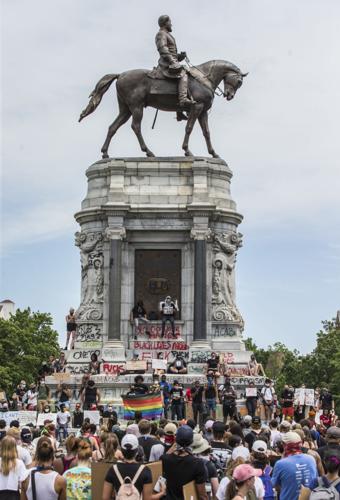Memorials, including one to George Floyd, were set up on the west side of the Lee Statue in Richmond, Va. Video by Alexa Welch Edlund/Times-Dispatch
The original opponent of the Robert E. Lee statue issued a stern prophesy after the monument was erected in 1890.
John Mitchell Jr. — newspaper editor, politician, banker and civil rights activist — predicted that the monument “will ultimately result in handing down to generations unborn a legacy of treason and blood.”
Mitchell, editor of the Richmond Planet, wasn’t done. He wrote of the black man: “He put up the Lee Monument, and should the time come, he’ll be there to take it down.”
The time has come. Gov. Ralph Northam is removing Lee from his pedestal as soon as possible. Richmond Mayor Levar Stoney will attempt to follow suit with Monument Avenue’s other Confederate statues in tandem with City Councilman Mike Jones.
John Mitchell, the great-great-nephew of John Mitchell Jr., could not be happier.
“Beautiful,” he said Wednesday. “It has to be done.”
And Mitchell, a Richmond-based web designer and musician, says that when that pedestal becomes vacant, “Of course, I would like to see my great-great-uncle up there.”
The possibilities are endless, but I can’t think of a better choice than Mitchell, a fearless anti-lynching crusader who organized a successful streetcar boycott in Richmond — a half-century before the Martin Luther King Jr.-led Montgomery bus boycott — and ran for governor of Virginia on a “lily black ticket” that included Maggie Lena Walker.
That we are at a moment no one saw coming is due to the Black Lives Matter protesters who cast an unflinching light on the ugly symbolism behind these monuments. Few images are as powerful as the light projection of George Floyd’s face onto the graffiti-marked Lee monument, as was done Wednesday night.
“It is young people, a new generation, that are leading us,” said Robert Johns, a relative of Barbara Johns, who as a 16-year-old schoolgirl in Prince Edward County became a heroine of the civil rights movement in Virginia.
Richmond’s monuments survived the martyrdom, at the hand of white supremacists, of nine black churchgoers in Charleston, S.C., and Heather Heyer in Charlottesville. But the national revulsion and furor unleashed by the torture of Floyd while in the custody of Minneapolis police officers landed at the doorstep of Monument Avenue.
The graffiti handiwork of the protesters, in its rawness, connected the dots of modern-day policing to its slave patrol roots. But what those monuments represent is far more vulgar than the graffiti. They send a clear message that black lives don’t matter at all. The legacy of enslavement and treason has bled into our present.
“Richmond is no longer the capital of the Confederacy,” Mayor Levar Stoney said Thursday. As if to remove all doubt, that message was repeated by a descendant of the man on the monument.
“The Lost Cause is dead,” said the Rev. Robert W. Lee IV. “A new cause is upon us, one of equality and justice and peace and concord.”
Stoney summoned the words of the always-eloquent James Baldwin: “History is not the past. It is the present. We carry our history with us. We are our history.”
Richmond has become so fixated at carrying the weight of history that it failed to realize what a burden it was, until the demonstrators made it impossible to ignore.
Northam spoke of how a little girl might feel upon standing in the 100-foot Lee circle and gazing up at a 12-ton monument, six stories high. “When it’s the biggest thing around, it sends a clear message: This is what we value the most.”
The monument, by its sheer scale, was designed to evoke shock and awe. It gave white supremacy a symbolic imperviousness — and worse, a veneer of virtue.
“In 2020, we can no longer honor a system that was based on the buying and selling of enslaved people,” the governor said.
The oppression of black folks will not end with the removal of these monuments. As Northam noted, racism is a system that touches every person and every aspect of our lives. But it’s a start.
The grassroots Virginia Defenders for Freedom, Justice & Equality cheered this turn of events in a statement Wednesday. It quoted member Joseph Rogers, a descendant of James Apostle Fields, who rose from enslavement in Hanover County to gain election to the Virginia House of Delegates, a year before the Lee monument went up.
“If we can dismantle the symbols of white supremacy, it means we can dismantle the legacy of white supremacy,” Rogers said. “We can save and improve public housing. We can fund underfunded schools. We can address police brutality. We can do it for Black folks, indigenous people, people of color, working-class whites.”
There will no doubt be resistance, because nothing progressive happens here without it. But allow us this moment of optimism amid a season of trauma. Moving ahead, the possibilities are endless in a space previously reserved for the celebration of oppression. We might salute the spirit of collective dissent that made this happen. Or we could pay a fitting and ironic tribute to Mitchell — a spiritual progenitor of the Black Lives Matter movement and a man who saw this moment coming.
“I think he would say ‘I told you so,’ ” his great-great-nephew said. “Sometimes, prophesy can be justice.”
And when the time comes, “I would fight to be one of those hands to bring that statue down.”





